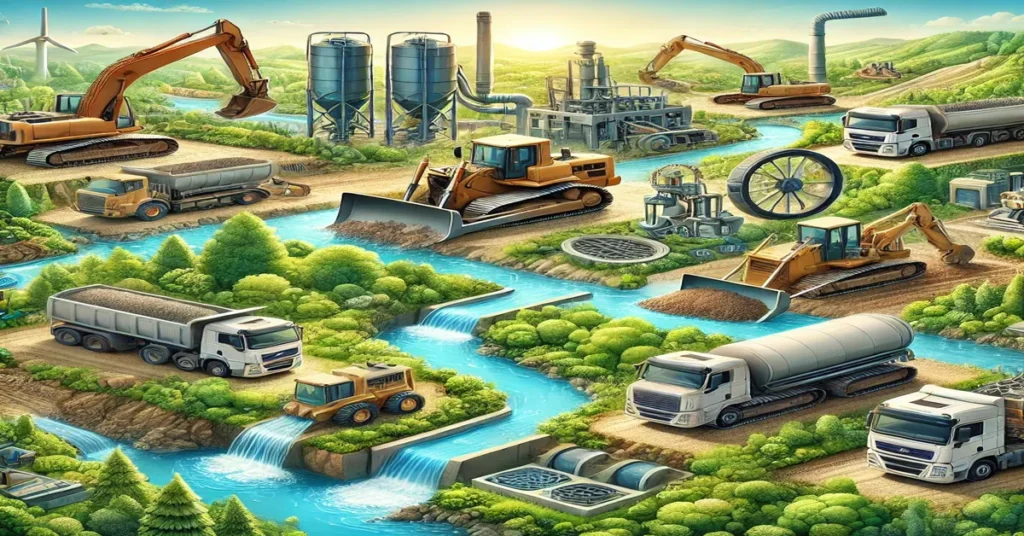Reclaimation equipment plays a crucial role in restoring ecosystems, recovering valuable resources, and rehabilitating land and water bodies affected by industrial or environmental degradation. As human activities such as mining, oil drilling, construction, and waste generation impact the environment, reclamation processes have become more essential than ever. Reclamation equipment, from soil stabilizers to water treatment systems, enables industries and governments to address environmental damage, restore ecosystems, and recover valuable resources.
In this article, we’ll explore the different types of reclamation equipment, their applications, benefits, and how they contribute to sustainable development. We’ll cover the tools used in land, water, and material reclamation, the technological advancements shaping the field, and the importance of reclamation in promoting environmental sustainability.
What is Reclamation?
Reclamation refers to the process of rehabilitating land, water, and resources that have been impacted by human activities. This can involve restoring ecosystems, recovering valuable minerals or materials, and stabilizing soil and water sources. Reclamation is widely used in industries such as mining, oil and gas, agriculture, waste management, and construction, where activities can result in degraded or contaminated environments.
Some examples of reclamation processes include:
- Restoring mined land to its original or usable state.
- Recovering valuable minerals or metals from waste materials.
- Treating contaminated water to make it safe for reuse.
- Stabilizing and replanting degraded soil to promote vegetation growth.
Types of Reclamation and the Equipment Used
There are several types of reclamation, each with specialized equipment and methodologies. Below are the main types of reclamation and the equipment associated with each:
1. Land Reclamation
Land reclamation involves restoring land that has been degraded by activities such as mining, construction, or agriculture. The goal is to return the land to a stable, productive, and safe state. Some common equipment used in land reclamation includes:
- Bulldozers and Excavators: Used to reshape and regrade land, bulldozers and excavators are essential for moving soil, rocks, and other debris. They help prepare the site for vegetation or structural development.
- Soil Stabilizers: Soil stabilizers treat soil with lime, cement, or other stabilizing agents to improve its structure and fertility. They are especially useful in areas where soil quality has been compromised.
- Hydroseeders: Hydroseeding equipment disperses a mixture of seeds, mulch, water, and fertilizers to promote vegetation growth on reclaimed land. This helps control erosion and restore natural ecosystems.
- Mulchers and Grinders: These machines are used to reduce plant material and organic waste into mulch, which can be spread over reclaimed land to enrich the soil and promote plant growth.
2. Water Reclamation
Water reclamation, or water recovery, focuses on treating and reusing water from wastewater, stormwater, or contaminated sources. Reclaimed water can be used for agriculture, industry, and even potable uses. Water reclamation equipment includes:
- Filtration Systems: Filtration systems, such as sand filters and membrane filters, are used to remove suspended particles and contaminants from wastewater. They are a crucial step in making water suitable for reuse.
- Reverse Osmosis Systems: Reverse osmosis (RO) systems remove dissolved salts and impurities from water through a semi-permeable membrane, creating purified water that can be reused for various purposes.
- Aeration Tanks and Reactors: Aeration tanks and reactors introduce oxygen into the water, promoting the breakdown of organic pollutants by aerobic bacteria. This helps reduce biological contamination in wastewater.
- Ultraviolet (UV) Disinfection Systems: UV disinfection uses ultraviolet light to kill bacteria and other pathogens in water, making it safe for agricultural or industrial use.
3. Material and Metal Reclamation
Material reclamation refers to recovering valuable materials from waste, scrap, or byproducts. This process is widely used in mining, electronics, and manufacturing to reclaim metals and other resources. Common equipment used in material and metal reclamation includes:
- Magnetic Separators: Magnetic separators are used to remove ferrous metals from other materials. They are often used in recycling plants to separate iron and steel from non-magnetic materials.
- Electrostatic Separators: Electrostatic separators use electric fields to separate materials based on their electrical conductivity. This equipment is often used to separate non-ferrous metals like copper and aluminum from waste streams.
- Crushers and Shredders: Crushers and shredders break down materials into smaller pieces, making them easier to process and separate. These machines are essential in reclaiming metals and other valuable materials from electronic waste and construction debris.
- Floatation Cells: Floatation cells are used in mining to separate valuable minerals from waste rock. By adding chemicals and air bubbles, the valuable minerals attach to the bubbles and rise to the surface for collection.
4. Soil Reclamation
Soil reclamation focuses on restoring soil health and fertility, particularly in areas affected by erosion, pollution, or intensive agriculture. Reclaimed soil can support vegetation, reduce erosion, and improve ecosystem health. Equipment used in soil reclamation includes:
- Soil Conditioners and Amendments: These materials are spread on degraded soil to improve fertility, pH balance, and water retention. Soil conditioners can include organic matter, gypsum, lime, and compost.
- Compost Spreaders: Compost spreaders apply organic compost to soil, enriching it with nutrients and microorganisms that support plant growth. This equipment is commonly used in agriculture and land reclamation.
- Erosion Control Blankets: Erosion control blankets are laid over reclaimed soil to stabilize it, reduce erosion, and retain moisture. They are often made from biodegradable materials like straw, coconut fiber, or jute.
- Terracing and Slope Stabilization Equipment: In hilly or sloped areas, terracing and slope stabilization equipment is used to create steps or terraces that prevent soil erosion and promote water retention.
5. Waste Reclamation
Waste reclaimation equipment involves recovering resources from solid waste, such as plastics, metals, and organic materials, often in recycling plants. The reclaimed materials are then reintroduced into the production cycle. Equipment for waste reclamation includes:
- Waste Sorting Machines: Waste sorting machines use sensors, conveyors, and mechanical arms to separate materials based on size, weight, or composition. These machines are vital for efficient recycling.
- Briquetting Machines: Briquetting machines compress loose material, such as metal chips or biomass, into dense briquettes for reuse or resale. This equipment is particularly useful in waste-to-energy applications.
- Incinerators with Energy Recovery: Incinerators can burn certain types of waste to generate energy. In waste reclamation, modern incinerators capture and convert the heat into electricity, reducing waste volume and producing power.
- Composting Equipment: Composting equipment processes organic waste into compost, which can be used as fertilizer in agriculture and landscaping. This equipment is essential in organic waste reclamation.
Benefits of Reclamation Equipment
Reclamation equipment has numerous environmental and economic benefits, including:
1. Environmental Restoration
Reclamation equipment is essential for restoring ecosystems degraded by industrial activities. By stabilizing soil, replanting vegetation, and removing contaminants, reclamation equipment supports biodiversity, reduces soil erosion, and enhances ecosystem resilience.
2. Resource Recovery
Reclamation equipment enables industries to recover valuable resources, such as metals, water, and organic material, from waste streams. This reduces the demand for virgin resources and lowers production costs by reintroducing reclaimed materials into the manufacturing cycle.
3. Reduction in Pollution
By reclaiming and treating waste materials, reclaimation equipment reduces pollution in air, soil, and water. For example, water reclamation systems remove contaminants from wastewater, protecting water quality and public health.
4. Economic Savings and Job Creation
Reclaimation equipment projects can save companies money by reducing waste disposal costs and creating valuable byproducts. Additionally, reclamation work supports job creation in environmental engineering, waste management, and equipment manufacturing.
5. Improved Soil and Water Health
Soil and water reclamation techniques, including soil stabilizers, composters, and water filtration systems, improve the health of degraded soil and water bodies, making them suitable for agriculture, industry, or recreation.
Technological Advancements in Reclamation Equipment
The reclaimation equipment industry has seen significant technological advancements that improve efficiency, reduce costs, and increase the effectiveness of reclamation projects. Some notable advancements include:
1. Automation and AI in Waste Sorting
Automation and artificial intelligence are transforming waste reclamation by improving sorting accuracy and efficiency. Advanced waste sorting machines now use AI and robotic arms to identify and separate materials, increasing the recovery rate and quality of recycled products.
2. Bioremediation Technology
Bioremediation uses microorganisms to break down pollutants and contaminants in soil and water. Equipment designed for bioremediation can distribute beneficial bacteria, fungi, or enzymes, making it possible to clean up contaminated areas more naturally and effectively.
3. Remote Sensing and Drones
Drones and remote sensing technologies are used in land reclamation to survey sites, monitor vegetation growth, and assess soil health. These technologies allow for more accurate reclamation planning and reduce the need for on-site personnel in hazardous areas.
4. Advanced Filtration and Desalination
New filtration and desalination technologies in water reclamation, such as advanced membrane systems, are making it easier and more cost-effective to reclaim water from highly contaminated sources. These technologies increase the availability of clean water for agricultural and industrial use.
5. Circular Economy and Closed-Loop Systems
Reclaimation equipment is increasingly integrated into circular economy systems, where waste products are continually recycled and reused. Closed-loop systems in industries like mining, agriculture, and manufacturing reduce waste and create more sustainable production cycles.
Challenges in the Reclamation Equipment Industry
While reclaimation equipment has numerous benefits, the industry also faces several challenges:
- High Initial Investment: Reclamation equipment can be expensive, and the high cost of purchasing and maintaining equipment may deter companies from investing in reclamation projects.
- Technical Complexity: Many reclamation processes are technically complex, requiring specialized knowledge and expertise. Proper training and skilled personnel are essential for operating reclamation equipment effectively.
- Regulatory Compliance: Reclamation projects often require compliance with environmental regulations, which can vary significantly between regions. Navigating these regulations can be challenging and costly for businesses.
- Environmental Risks: Reclamation projects can sometimes have unintended environmental impacts, such as disturbing habitats or releasing contaminants. Proper planning and environmental assessments are essential to minimize risks.
- Variable Resource Recovery Rates: The efficiency of reclamation processes can vary, depending on factors like the type of material being reclaimed and the level of contamination. This variability can impact project profitability.
Conclusion
Reclaimation equipment is essential for environmental restoration, resource recovery, and sustainable development. Whether it’s restoring mined land, reclaiming metals from electronic waste, or treating contaminated water, reclamation equipment helps industries reduce their environmental footprint and recover valuable resources. As technology advances, reclamation equipment will continue to play a critical role in creating a sustainable future and mitigating the impacts of industrial activities on the environment.
For industries and governments committed to environmental responsibility, investment in reclamation equipment represents a vital step towards a cleaner, greener, and more sustainable world.
FAQs About Reclamation Equipment
- What is reclamation equipment used for? Reclamation equipment is used to restore degraded land, recover valuable resources, treat contaminated water, and improve soil and environmental health.
- Which industries use reclamation equipment? Reclamation equipment is widely used in industries such as mining, oil and gas, agriculture, waste management, and construction for environmental restoration and resource recovery.
- How does reclamation equipment contribute to sustainability? By restoring ecosystems, reducing pollution, and recovering resources, reclamation equipment helps reduce environmental impact and promotes sustainable practices across industries.
- What are some common types of reclamation equipment? Common reclamation equipment includes soil stabilizers, water filtration systems, magnetic separators, hydroseeders, and compost spreaders, each designed for specific reclamation tasks.
- What is water reclamation equipment? Water reclamation equipment treats and purifies wastewater or contaminated water, making it suitable for reuse in agricultural, industrial, or potable applications.
- What are the challenges associated with using reclamation equipment? Challenges include high costs, technical complexity, regulatory compliance, environmental risks, and variability in recovery rates, all of which require careful planning and expertise.







